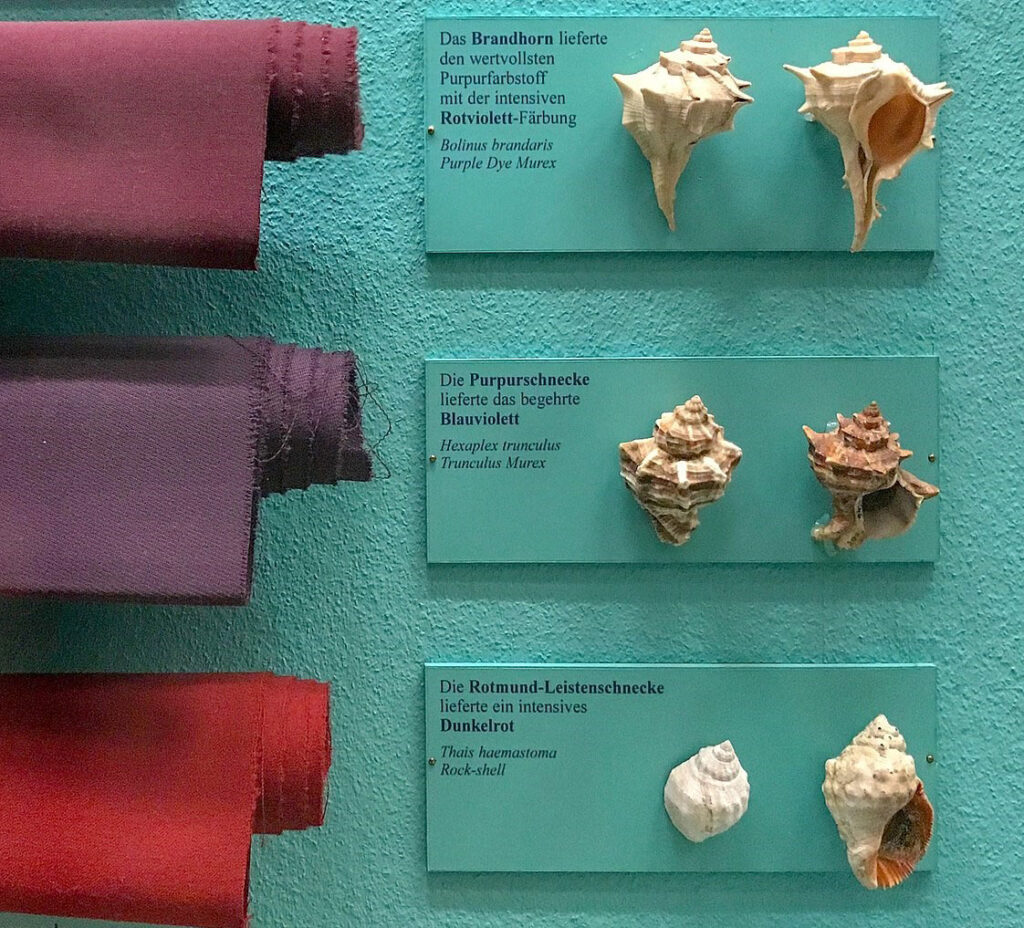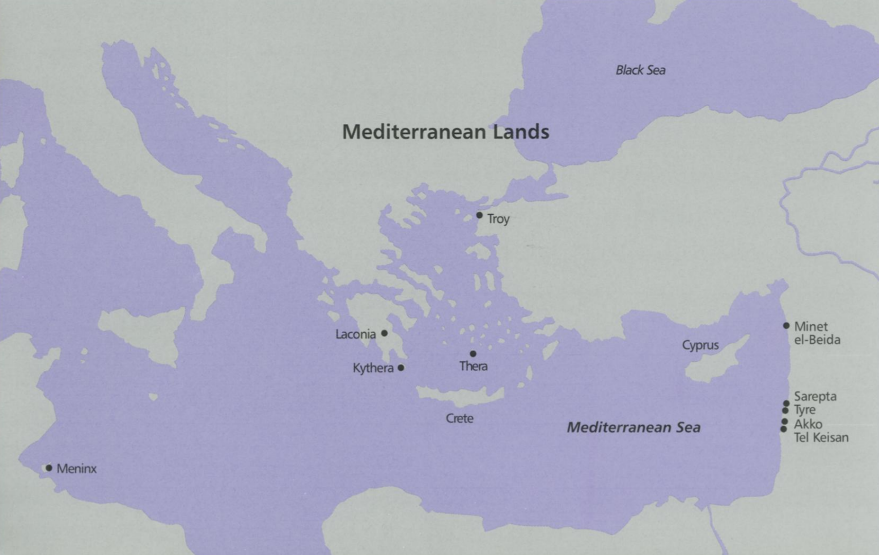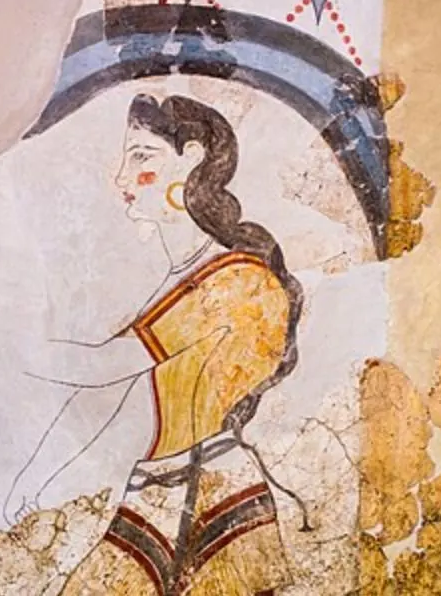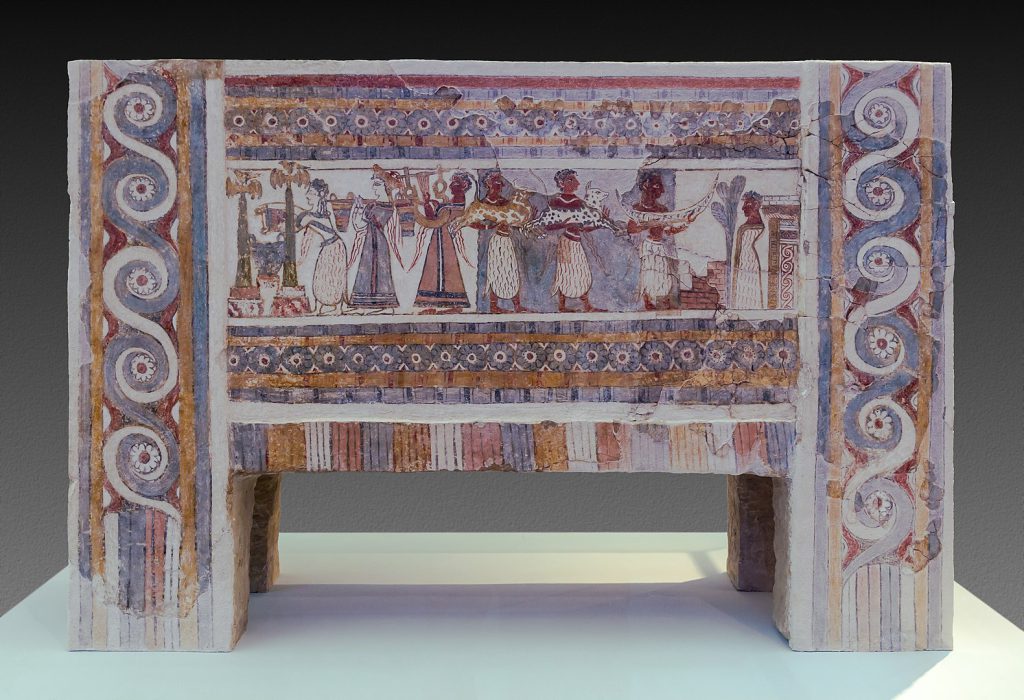Tyrian purple, also known as ‘royal purple,’ was the most expensive dye in the ancient world qensen 1963). Indirect evidence about its value is provided by Ugaritic texts of the 14th century BCE, in which various types of dyed woolens are listed with their prices. Some of these textiles were evidently dyed with Tyrian purple, as their higher prices would suggest (Stieglitz 1979:19). Homer used the special term haliporphyros, ‘sea-purple’, to refer to this dye (Odyssey 6.53: 306), perhaps in order to distinguish it from purple-dye imitations. By the time of Diocletian, in 301 BCE, we know that wool dyed with Tyrian purple was literally worth its weight in gold, as is stated in his Edict on Maximum Prices 24. The basic raw material for the dye production was a liquid, obtained directly from the hypobranchial glands of Mediterranean mollusks.
The shellfish utilized in this dye manufacture were primarily Murex trunculus L. (=Hexaplex) and Murex brandaris L. (=Bolinus). A third variety, Purpura haemastoma L. (=Thais), was used occasionally. Each shellfish produced only a few drops of the precious secretion, which was then boiled in salt water to create the dye. In order to produce Tyrian purple in commercial quantities, many thousands of shellfish were required. Pliny, writing in the first century BCE, provides the only actual recipe for the preparation of the dye solution. He reports (Natural History 9.62.135) that in order to dye 1,000 pounds of wool, it was necessary to use some 200 lbs. of Purpura flesh (his term for this shellfish was bucinum), as well as 111 lbs. of murex. In this process, the gland was extracted from the larger specimens only.

The small shellfish were crushed, shell and all. Such a procedure was also observed earlier by Aristotle (Historia Animalium 5.15.22-25). The entire mass, with water, was then placed in leaden vats and simmered. The exposure of the liquid to light, coupled with the prolonged simmering of the flesh mass (it was cooked for nine days!), produced the notorious stench for which this industry was noted in antiquity. Pliny (Natural History 9.60.127) also states that in his day.
Since these shellfish had to be caught by rather laborious fishing and/or diving in shallow water, the price of the dye, as noted above, was enormous. Therefore, a great variety of dye substitutes was in use during Greco-Roman times, as we know from an ancient papyrus that lists recipes for producing purple dye substitutes (Lagercrantz 1913). These imitations were produced from plant as well as mineral sources. Still, none were as color-fast as the true “royal purple,” hence the continued demand in antiquity for textiles colored by this highly prized dye. The dye could be produced in a great variety of shades, depending upon the mixture of the different shellfish utilized. Variations could also be made by chemical means, such as light conditions and reducing agents. The resulting colors included red, blue, and dark purple, the latter being considered the most noble of the tints. All shades were utilized primarily to color ceremonial garments. Two of the best-known examples are the purple stripes on the Roman toga purpurea and the blue stripes on the Jewish tallit, or “prayer shawl. The Hebrew name for this blue dye was tekelet (Exodus 26:11; see Ziderman 1987), and we may note here that according to Rabbinic rulings, only the true tekelet dye (made from mollusks) should be used for coloring the prayer shawl (Tosepta Menachot 9,16). These religious rules were probably a response to the use of substitute dyes.
According to current theories, the production of Tyrian purple was originated and monopolized by the coastal Caananites, those people called Phoenecians by the Greeks. This development presumably occurred sometime in the Late Bronze Age (1550-1200 BCE). Indeed, the earliest archaeological evidence for Canaanite purple dye production-the heaps of discarded shells and their fragments-are those unearthed at Minet el-Beida (the harbor of Ugarit), dated to the 15th-14th century BCE; Serepta and Tel Akko (13th century BCE) and at Tel Keisan (11th century BCE; Karmon and Spanier 1988:184). There are, however, archaeological and epigraphic indications from the Aegean, which suggest that the “royal purple” industry was first developed there, by the Minoians on Crete, before 1750 BCE.

The current scholarly theories attributing to the Phoenicians the origin of the Tyrian purple industry can actually be traced back to the Roman era. The Greek rhetorician Julius Pollux, in the second century BCE, relates a charming tale (Onomasticon 1.45-48) of how the hound of Herakles bit into a murex fish on the shore at Tyre and thus discovered its dye. Herakles then divulged this delightful discovery to Phoenix, the king ot Tyre. This took place, according to Pollux, some seven generations before the war at Troy.
Now in the Roman era it was quite fashionable to discuss and theorize on the origins of all sorts of inventions. The purple industry-which was still quite an active art in that era-was not exempt from these speculations. Indeed, the Romans had themselves developed techniques for the artificial breeding of murex and other shell-fish, in rock-cut pools called piscinae. A fascinating description of how to construct such fish-ponds, adjoining a sea-side villa, is provided by Lucius Junius Moderatus Columella (De Re Rustica 8.16.7), about 60 BCE. The origins of the Tyrian purple industry were, therefore, of some interest to the Romans. However, evidence in the Aegean at the turn of the century suggested that the purple dye industry originate in Crete.

The first archaeological evidence of purple shells, constituting the debris of purple dye production, was already reported by Heinrich Schliemann (1880:115) at Troy. In 1903, the British archaeologist R C. Bosanquet found numerous murex fragments at a Middle Minoan site on the small island of Kouphonisi, off the southeast coast of Crete (Bosanquet 1904:321). However, he described the details of his finds only within the text of an unrelated article, which he published 37 years later (Bosanquet 1939-40). In 1904, Bosanquet also found purple shell remains at the large Minoan site of Palaikastro in Eastern Crete. 40). He, therefore, proposed that the Minoan purple dye industry, dated to the Middle Minoan Era (2000-1600 BCE) preceding the Phoenician industry, but few accepted his opinion.
We should note here that the murex shellfish are edible, and when they are found in small numbers, such as at the Early Minoan site of Myrtos (Warren 1972:263), they are found in small numbers, such as at the Early Minoan site of Myrtos (Warren 1972:263), they are presumably associated with the diet and not with the dye. But it is also likely that these Early Minoan fishermen also discovered the dye, in the same way the Hound of Herakles did many centuries later.
In 1981, I set out to investigate sea-purple origins by analysis of pertinent archaeological and epigraphic data, starting with a coastal survey on Crete. At Palaikastro, which is identified with Classical Heleia, I found a large surface deposit of murex remains on the southern slopes of the Kastri. Most of these were fragmentary, but some were small whole shellfish. These are, presumably, from the same deposit noted by Bosanquet in 1904. In addition, numerous murex are located within the remains of a well-built stone structure located on a headland in the bay southeast of the Kastri.
On the island of Kouphonisi, which is identified with Classical Leuke, I succeeded in locating the Minoan site visited by Bosanquet in 1903. It is situated on the slope of a hill overlooking the north shore of the island. Besides the murex remains, pottery fragments, and foundations of a large stone structure, it should be noted there are quite a few obsidian chips on the surface of the site.
The water source for the modern fisherman is now located on the shore directly below the Minoan site. It was presumably also utilized in antiquity, for near it are remains of substantial industrial facilities. I believe that these are the remains of an actual purple dye factory, probably dated to the Hellenistic era. At that time, the island of Leuke was a center of Tyrian purple manufacture, as is know from Cretan inscriptions of the second century BCE (Guarducci 1940:104).
These manufacturing remains near the water source include stone and clay vats, as well as basins and channels for the handling of liquids. The location of the site on the shore near a water source is ideal, since both sea-water and fresh are required in the dye production. Some excavations of the Greco-Roman town of Leuke, located on the shore west of this area, have been undertaken (Papadakis 1983), but as far as I know, the industrial site itself has not been excavated, and its date is therefore still speculative.

In addition to Palaikastro and Kouphonisi, murex remains have also been found at other Aegean Bronze Age sites. These include the Middle Minoan levels of three major sites: Kastri on the island of Kythera (Coldstream et al. 1973: 36, 282), Knossos itself (Hutchinson 1962:239)-presumably from a near-by factory on the shore-and at the palace of Mallia (Vogler 1984). In the Late Helladic era, we find murex remains both in and outside of Greece: at Troy VI, dated to 1425 BCE (Blegen 1937) at Hala Sultan Tekke on Cyprus dated to the Late Cypriate period (Reese 1987:205). Akrotiri on Thera, has now yielded remains suggesting “probable local production” of purple dye (Aloupi et al. 1990), dated to Late Minoan IA, ca. 1550 BCE.
To this archaeological evidence from the Aegean, we should also add a significant epigraphic find. The Mycenaean Greek term po-pu-re-ia ‘purple’ is found in several administrative Linear B tablets from Knossos, which deal with textile allocations. One of these tablets (KN X976) actually contains the expression wa-na-ka-te-ro po-pu-re-[ I ‘royal purple’. This is the first written attestation of a term which in later ages became synonymous with ‘Tyrian purple’. It is significant that this term is first attested in a Mycenaean Greek text from Knossos. The Classical Greek root porphyr- is used to designate both the mollusk and its dye, but it is not an Indo-European word. Astour (1965) proposed, unconvincingly to my mind, to derive this term from a Canaanite root *parpar meaning ‘to churn, to boil’. However, the Canaanite word for the purple mollusks was evidently hillazbn-a word of unknown origin attested only in Talmudic Hebrew. The actual Phoenician terms for the shellfish and its dye are still not attested. As for the Mycenaean term porphyr-, I would suggest that this was originally a Minoan word, borrowed by the Mycenaeans when they learned from the Minoans to produce the dye. It may well be that Minoan art has preserved depictions of garments dyed with ‘royal purple’.

Probably the best-known Minoan sarcophagus (above), dated to about 1450 BCE, is the one found at Hagia Triada that illustrates elegantly dressed men and women. Their garments are decorated with purple stripes of various shades. A famous Minoan priestess figurine, 1600 BCE, also has what appear to be purple decorations on her attire, as do the dresses of the noble ladies depicted on the frescoes of Thera, about 1550 BCE. After Minoan power on Crete was supplanted by that of the Mycenaean Greeks, about 1450 BCE, the Greeks, Trojans, and the peoples of Anatolia continued to produce the purple dye. We should recall here the Homeric reference (Iliad 4.141) to purple colored ivory (!) used by Maionian and Carian women. The Troad tradition of Tyrian purple manufacture was also noted by Aristotle (Historia Animalium 5.15.547), who mentions the waters off Sigeion, Lekto, and Caria as being rich in purple shells.
The Canaanite dye industry in the Levant was certainly not a monopoly. Indeed, the Greeks, Phoenicians, and others continued to manufacture Tyrian purple throughout antiquity. By the Roman era, it was already unknown who had first invented the ‘royal purple’ dye, and it was only then attributed to a mythical Phoenician source and dated to the era before the Trojan war. The archaeological evidence now available from the Aegean suggests that this industry was not of Mycenaean, nor of a Canaanite origin. It indicates that the Minoans on Crete and some Minoanized islanders, such as those on Kythera, were already manufacturing sea-purple in the Middle Minoan period, ca. 1750 BCE. It also seems certain that this dye was being produced by the people of Thera at the end of the Middle Minoan era. The Mycenaeans, Trojans, Cypriotes, and Canaanites then continued to develop this industry in the Late Helladic period. The Bronze Age Canaanites and their Iron Age Phoenician descendants were not the actual originators of this dye. It was most likely a Minoan contribution, developed before 1750 BCE, which was then adopted by others, including the Canaanites-Phoenecians.
Source: The Biblical Archaeologist Vol. 57, No. 1 (Mar., 1994) , pp. 46-54 (9 pages).For the full bibliography and original photos and graphics, visit Dr. Steiglitz’s original paper at JSTOR.
Additional photo credits: Akrotiri fresco from the House of Ladies – Akrotiri Museum

